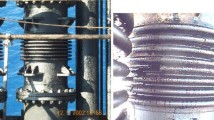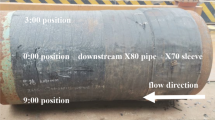Abstract
The problems of bellows expansion joints conditioned by their design features and the quality of the heat carrier are considered. It is testified that typical damage of bellows expansion joints are deformations, changes in geometric characteristics, and through defects of structural elements. Prevention and timely detection of damaged bellows expansion joints is an important task of the heating system’s operation. Examples of damage to bellows expansion joint elements are presented, including those with corrosive destruction of pearlitic steel corrugated inner layers and outer high-alloyed steel corrugations. Some survey results are presented and factors are analyzed that may affect the damageability of bellows expansion joints of the main heating network pipelines at PAO MOEK1. The causes and dominant damage mechanism of bellows expansion joints, caused by the formation of crevice defect with penetration of the heat carrier into the inner space of the pearlitic steel corrugated layers, have been established. Practice has shown that most of the damage is detected in pressure testing and is associated with mechanical deformations of the bellows without depressurization and without unsealing and loss of the heat carrier. Four main corrosion and damage stages of heating system bellows expansion joints are identified. It is proposed, depending on the initial and operating conditions, to consider possible scenarios of a two-stage mechanism of destruction of bellows expansion joints, including the development of a crevice defect up to the through leakage of heat carrier into the bellows interlayer space and corrosion damage to the inner corrugated bellows surface. Recommendations to prevent damage to bellows expansion joints of heating systems are provided.






Similar content being viewed by others
REFERENCES
L. V. Chugin and V. I. Shlapakov, “Analysis of the accident rate of heating networks and the planning of pipe replacement in an automated control system for the operation of heating networks,” Nov. Teplosnabzh, No. 11, 36–39 (2014). http://www.rosteplo.ru/Tech_ stat/stat_shablon.php?id=2920.
V. I. Matveev and S. Ya. Alibekov, “Estimating the state of the metal of pipelines of heating networks by the results of surveys of corrosion indicators and engineer diagnostics,” www.rosteplo.ru/Tech_stat/ea_2495.htm. Accessed May 29, 2018.
G. V. Tomarov, A. E. Nikolaev, V. N. Semenov, A. A. Shipkov, and S. V. Shepelev, “Study of the causes and identification of the dominant mechanisms of failure of bellows expansion joints used in district heating system pipelines at MOEK,” Therm. Eng. 62, 456–463 (2015). https://doi.org/10.1134/S0040601515060117
Duplex Stainless Steels '91, Proc. Conf., Baune, France, Oct. 28–30, 1991, Ed. by J. Charles (Les Editions de Physique, Les Ulis, France, 1991), Vol. 1. https://www. tib.eu/en/search/id/TIBKAT%3A124397204/Duplex-stainless-steels-91-28-30-octobre-1991-Beaune/.
Author information
Authors and Affiliations
Corresponding author
Additional information
Translated by A. Kolemesin
The names of organizations are given in accordance with their statutory documents.
Rights and permissions
About this article
Cite this article
Tomarov, G.V., Shipkov, A.A. Bellows Expansion Joints of the Main Heating Network Pipelines: Problems and Damage Prevention. Therm. Eng. 66, 367–371 (2019). https://doi.org/10.1134/S0040601519050100
Received:
Revised:
Accepted:
Published:
Issue Date:
DOI: https://doi.org/10.1134/S0040601519050100




